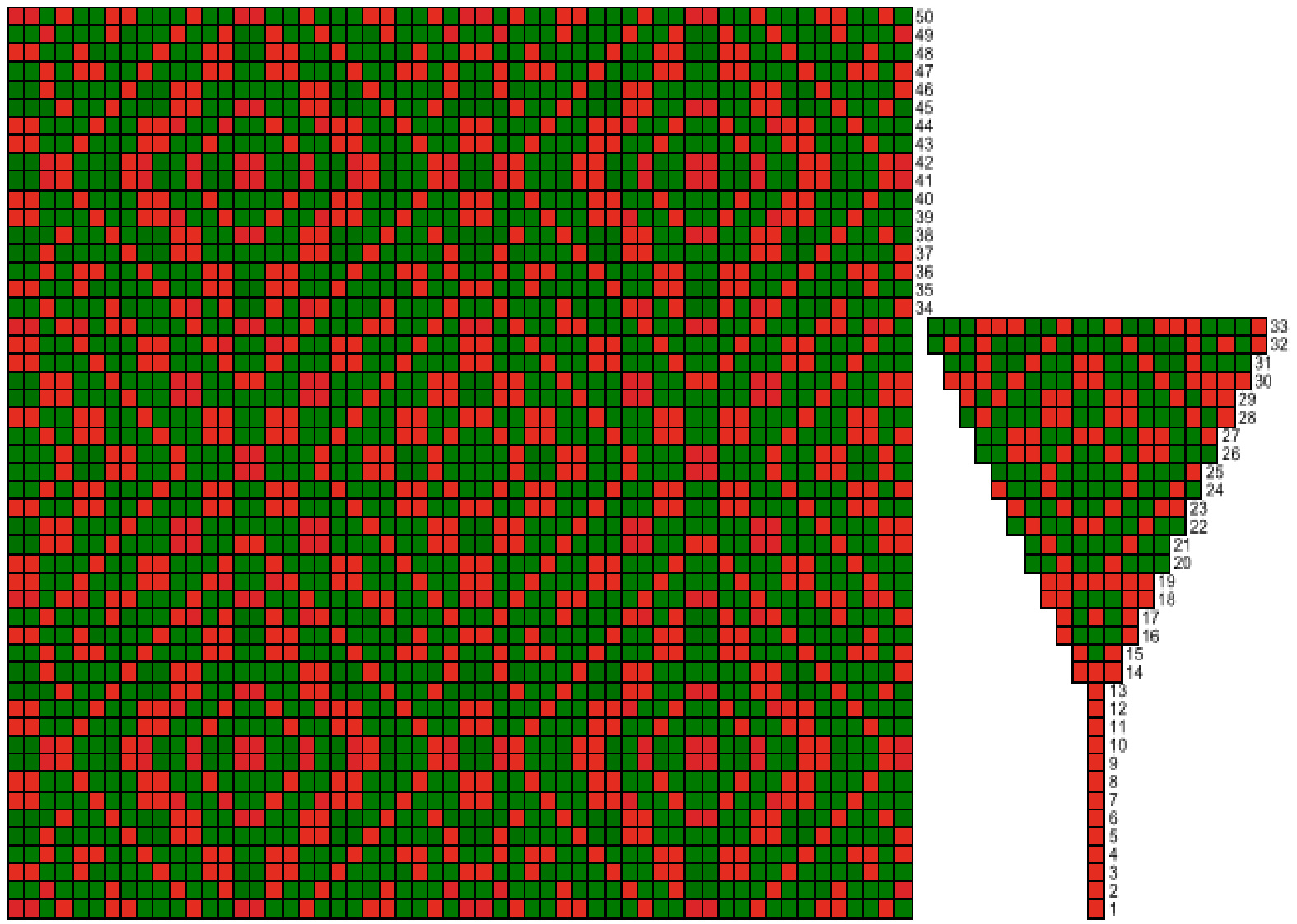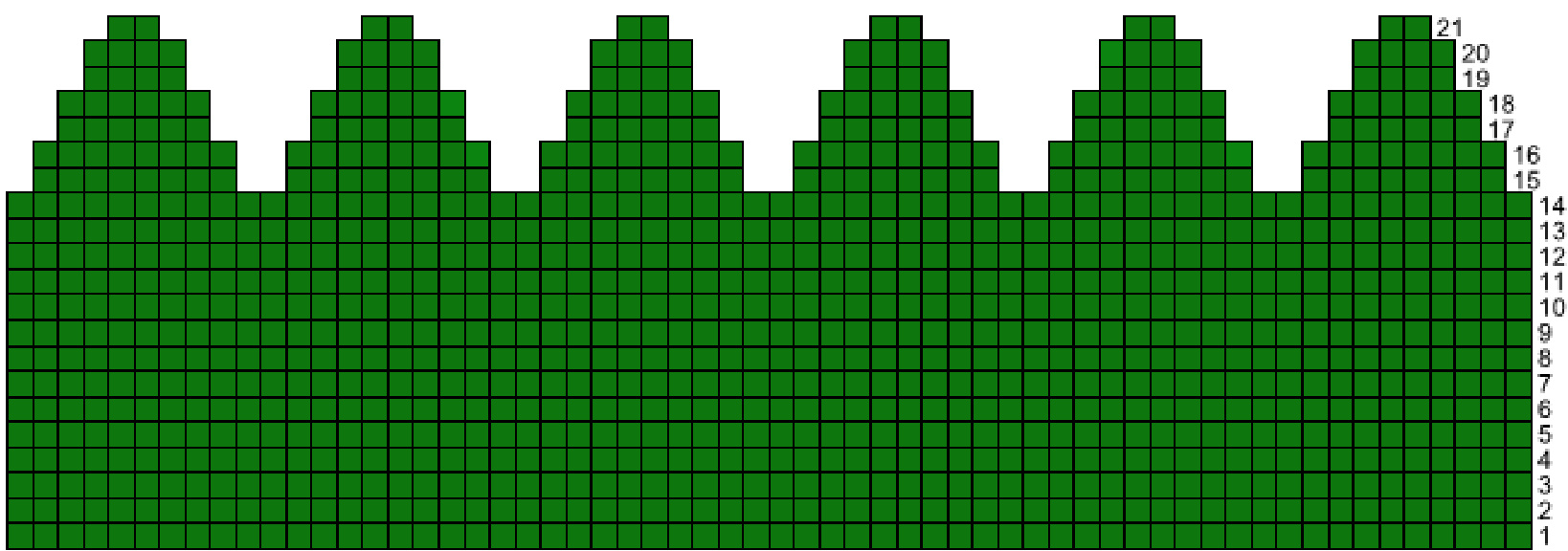CHRISTMAS MITTS
Deborah Tomasello
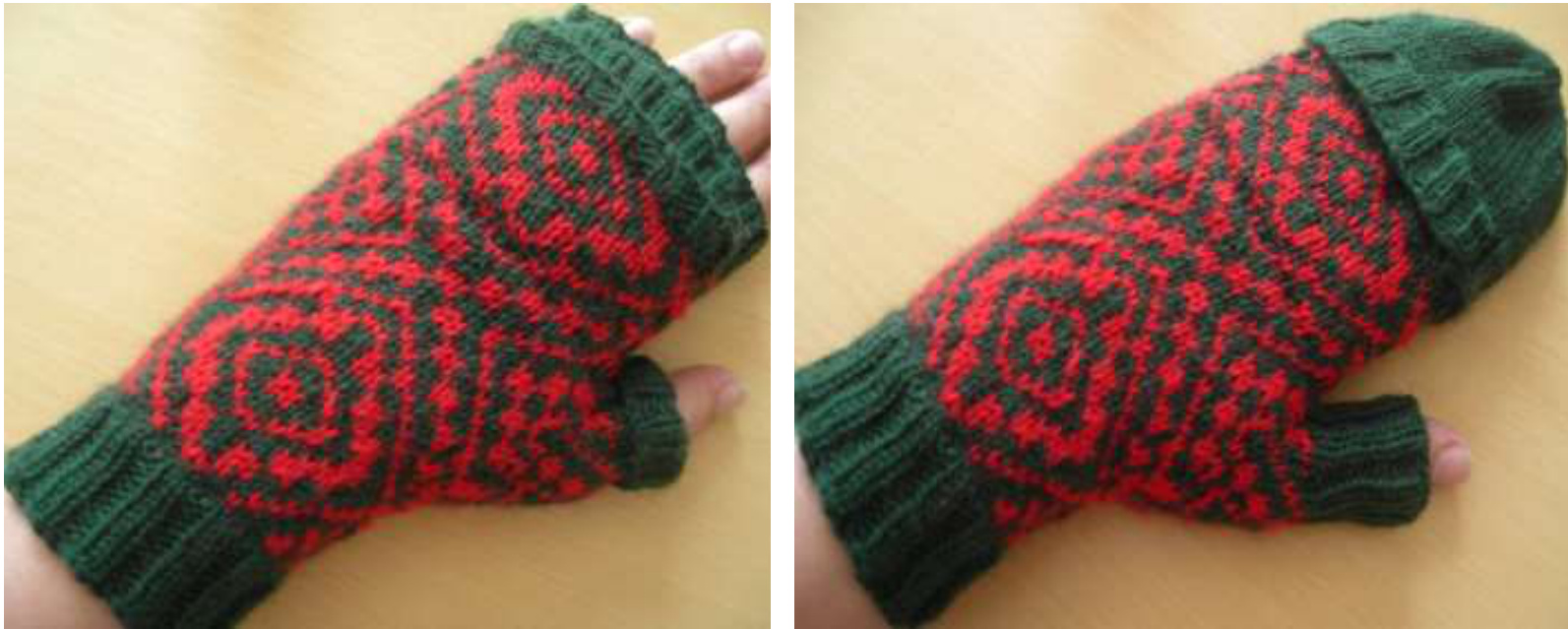
Test-knitted and edited by Emma Hewitt. Cover photo: Emma Hewitt Sizes: Woman's and Teen Medium Materials: 1 ball each of Knit Picks Palette: Serrano and Ivy. Five #3 or #4 DPNs (or size needed to obtain gauge) Stitch Marker Tapestryneedle Gauge: 32 stitches = 4" using #3 needles. Abbreviations: K2TOG: Knit 2 stitches together M1: This is not "the" M1 stitch. It is the Bumpless M1. It is a modification of KFB. See my video tutorial here: https://www.youtube.com/watch?v=syFeOy1B9ok
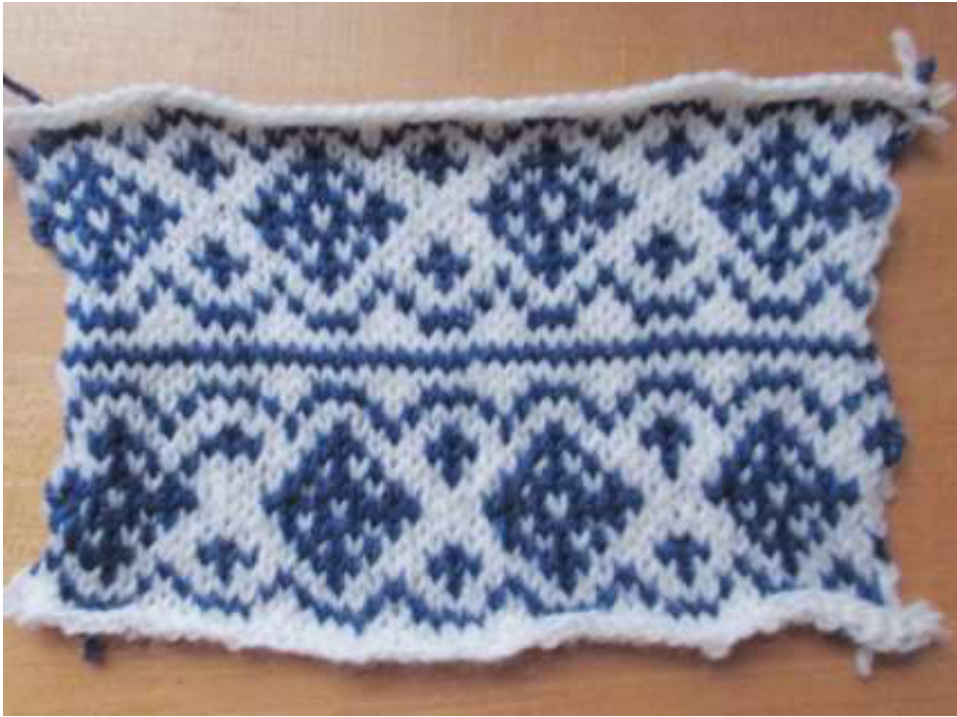
In the above swatch, I knitted the same motif across the piece, and then I repeated it. The only difference I made was the position in which I held my yarns. In the bottom half, I held my yarns so that the blue was dominant, that is to say more obvious than the white, on the front of the work, and the white receded into the background. On the top half, I knitted the same stitches but I held my yarns so that the white dominated and the blue receded. You see a definite difference in the appearance of the motifs when comparing the top and bottom halves of my swatch.
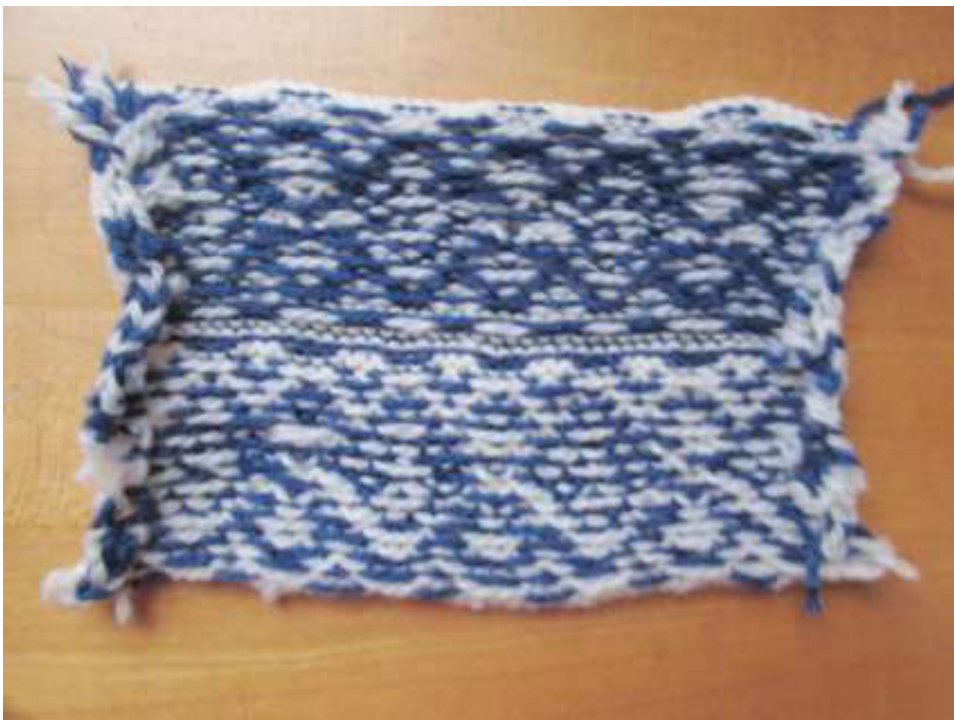
Viewing my swatch from the back, you notice that the color that dominated on the front recedes on the back, and the color that was recessive on the front dominates on the back. A color cannot be dominant both on the front and the back at the same time. So, how do you control for this? How does a color become dominant? I have read many explanations of color dominance, and frankly, they all leave me scratching my head. Terms are used like "over" and "under," which are nonsensical to me. Over where? Under where? Also, each knitter has her own yarnholding method. We need an explanation that works no matter how we hold our yarns. First, it is important to point out that, whatever way you hold your yarns when stranding, you want to maintain the same position throughout the piece so that you catch your floats the same way, consistently. That said, here's how color dominance happens. (And it happens whether you like it or not!) The color that will dominate---or stand out—-on the front of your work is the color that consistently lies closer to your work as you go. In the above example, on the bottom half of the front of the piece, the blue is more prominent than it is on the top portion of the piece. Thisis because it lay closer to the piece as I was working the bottom half. How do we know this? Look at the back of the swatch. The bottom on the back shows more white relative to the top of the swatch. You see more white because the floating yarn, the white, is floating over, or around, the blue...it lies further from the piece, has farther to travel, than the blue. Because the white liescloser to you on the bottom half when viewing the back, it is more visible to you than is the blue. Because it is more visible—dominant—on the back, it cannot be, at the same time, the dominant color on thefront. No matter how you choose to hold your yarns, one in each hand, both in the right hand, or between your toes as I do, the above rules apply. Try a swatch as I did. Try knitting with the yarns in one position and then switching them. Take note of the color that has to travel to float around the color that lies closer to the work. The one that has to travel to float around the close color is not the color that will dominate on the front of your swatch, but it is the color that will be most evident on the back. Try knitting this chart with two, highly-contrasting colors and DPNs so that you are working in- theround. You will cut the swatch open when you complete it:
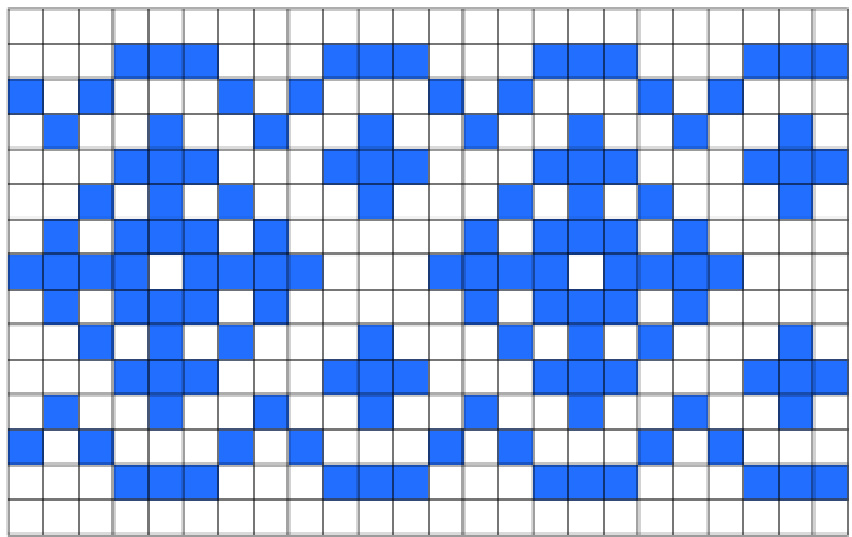
Pocket (Optional): CO 20 stitches with either color. Knit, back and forth in stockinette, about 30 rows or 3.5 inches. End with a purl row. DO NOT Bind off. Steam block. Set aside.
MITTS (MAKE TWO)
Mitt: With DPNs, (You might want to use a #4 DPN, rather than a #3 this time, because the chart is worked on a fewer than usual number of stitches for a mitt.) CO 56 sts using Ivy. Join to work in the round taking care not to twist sts (if using circs) Knit 2x2 rib for 26 rounds, or to desired cuff length Then follow CHART A through round 13. CHART A K1, place marker between fist two stitches. You are merely placing a marker after the very first stitch. This first stitch will eventually become the thumb. So, you will be working the pattern on 56 stsstill. Follow chart for 13 rounds. Continue to follow chart, and inc for thumb as follows: To increase thumb: Round 14: m1, k1, m1 in first st (3 sts now in first st). Continue to k sts as sh Round 15: knit all sts according to chart Round 16: m1, k3, m1, continue to k sts as shown around Round 17: knit all sts around according to chart Round 18: m1, k5, m1, continue to k sts as shown around Round 19: knit all sts around according to chart Round 20: m1, k7, m1, continue to k sts as shown around Round 21: knit all sts around according to chart Round 22: m1, k9, m1, continue to k sts as shown around Round 23: knit all sts around according to chart Round 24: m1, k11, m1, continue to k sts as shown around Round 25: knit all sts around according to chart Round 26: m1, k13, m1, continue to k sts as shown around Round 27: knit all sts around according to chart Round 28: m1, k15, m1, continue to k sts as shown around Round 29: knit all sts around according to chart Round30: m1, k17, m1, continue to k sts as shown around Round 31: knit all sts around according to chart Round 32: m1, k19, m1, continue to k sts as shown around Round 33: knit all sts around according to chart Round 34 Move 21 thumb sts to fifth DPN (or waste yarn) to be worked as thumb later. M1\* st in next st so you will be working the chart's 56 sts. Follow chart around with 64 stitches on needles. Rounds 35 to 50: Knit chart. (The mitt will be a minimum of 1 inch longer. If you want a shorter mitt, you might want to rip back some rounds before proceeding with the next step). If adding a pocket, do so here: Pocket: Round 51: Add pocket—Knit 6 stitches. Move next 20 sts to stitch holder. Retrieve needle with pocket stitches, and with pocket front (stockinette side) facing you, continue to knit chart with these stitches. Detach allbut the color you used for knitting your cuff, and using that color, knit 2x2 rib twice as long as you want the cuff length. Bind off loosely. Fold cuff back overitself. If you added a pocket, Move 20 stitches from stitch holder to needle. Attach ribbing color and knit 2x2 rib for 6 rows. Bind off. Sew rib sides to mitt, creating the pocket top. When the mitt cuff is folded back, it will hide the pocket opening.
Thumb:
Pick up 3 sts from body of mitten, knit 21sts on 5th DPN (or waste yarn) for a total of 24thumb sts, join. Knit 2x2 rib for 2" in Ivy. BO.
Mitten Cap:
CO 60 sts in Ivy. Do several rounds of ribbing to match top of mitt. Follow Chart B for 21 rounds. 12 sts left on needles. K2TOG around. 6 sts remain. Move all 6 sts from needles to tapestry needle, and pull tightly. Secure from the inside. Finishing: Sew up sides and bottom of pocket on inside of mitt. Attach mitten cap to mitten on pocket side at base of ribbing. Tie and trim all yarn ends. Wash and block. Copyright 2015 by Deborah Tomasello All rights reserved. This pattern or any portion thereof may not be reproduced or used in any manner whatsoever without the express written permission of the publisher. WARNING: Giving or accepting a free copy of this pattern to another, without permissionof the designer, is stealing.
